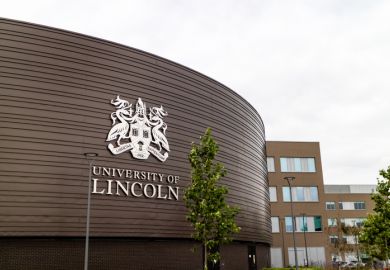It is hardly surprising that the Office of Fair Trading has started its enquiries. Contrary to plans, nearly all English undergraduate fees are already shoved up against the £9,000 wall erected only last year. Is this failed policy in terms of providing real choice to students, in facilitating competition or creating a real “market”? The OFT will ask these and, we can expect, many harder questions about course offerings, profits, subsidies and the veracity of claims made to students.
Charging less than £9,000 brings media condemnation, of being “substandard” or “crap”, even if only two years ago you were happily gaining just £6,000 or so for teaching a student on an average lecture-based course. Another word is “cheap”. In July, The Daily Telegraph website listed the “Top 12 cheapest universities in England”, revealing the 12 “true believers” still hanging out for average fees of less than £7,500. Staffordshire University leads this inverse list, and Teesside, Harper Adams, Leeds Trinity, Cumbria, London Met and Bolton all weigh in below £7,000 for 2013-14.
Of course, this isn’t cheap by European standards. Compared with average undergraduate tuition fees of less than £1,000 in continental Europe, even the most cheap-and-cheerful English fees look enormous. And compounded by elevated rates of interest over the coming several decades, they might well be!
English universities fear ‘looking cheap and thereby losing status’. Price equals quality in this perverse world
Yes, English universities fear “looking cheap and thereby losing status” (“Protective tariff”, Times Higher Education, 8 August). Price equals quality in this perverse world. Or so it appears to most student consumers – provided someone else is lending you the money.
Not so strangely, this equation does not apply to postgraduate taught students, who don’t have such deferred loan schemes. Their average English fee is somewhat shy of the budget-class £6,000, although there is no hard evidence to suggest that postgraduates are inherently cheaper to teach than undergraduates. Many a Russell Group university undercuts a post-1992 in the low-priced world of postgraduate taught study. And there is no loss of status.
The forward gallop of undergraduate fees could be because nearly everyone rushes to the price wall because it is there. A frequent suggestion is that the rush might not occur if the wall were not there. Alternatively, this could just be blatant sector-wide cross-subsidy of a threatened corner of university operations: of the loan-backed, gullible undergraduate subsidising the fee-paying domestic postgraduate. But not, of course, subsidising the international student, who might pay two or three times as much for the same postgraduate taught course, and an extra 30-plus per cent premium for the same undergraduate course.
Put another way: the taxpayer, through the agency of the overpaying, over-loaned domestic undergraduate student, cross-subsidises the upfront, underpaying domestic postgraduate student.
Now, with the University of Oxford’s vice-chancellor, Andrew Hamilton, pitching for £16,000 – the “true cost” of the Oxford “undergraduate experience” – and Nick Petford, vice-chancellor at the University of Northampton, predicting that some universities could charge as high as £20,000 – because they can – the customary bipartisan etiquette of waiting for an election, across which to hide harder decisions in university policy, is being undermined earlier than expected. The jackhammers are already out to dismantle last year’s high wall.
In whose interest, I wonder? Probably not most students, nor most taxpayers. Probably not even any political party. More certainly, it benefits our universities. And most certainly our staff, by fending off harder reform and topping up soft-minded pension schemes.
How different this behaviour is from the US, where the president is repeatedly on the hustings driving university and college tuition fees down. After 30 years of rampantly rising charges – outstripping rises in real family incomes by a factor of at least 10 – US student fees are becoming unsustainable. But unlike UK Prime Minister David Cameron, President Barack Obama is proudly promoting “affordable education”.
Responding to the reductions in public higher education funding now occurring in most American states, Obama pledged in his State of the Union address on 12 February to promote “the most bang for your educational buck”, through changes in the Higher Education Act, and the introduction of a College Scorecard to reveal true “value for money”. He went on: “Taxpayers cannot continue to subsidise the soaring costs of higher education. Colleges must do their part to keep costs down, and it’s our job to make sure they do.”
Obama’s remedy has three features, which he summarised in August at the State University of New York at Buffalo: “Increasing value, encouraging [mainly online] innovation, helping people to responsibly manage their debt.” And the funding rewards go to “those that keep tuition and other costs low for students” (US News website, 30 August).
The president is not alone. An optimistic “$10,000 degree” (£6,245) initiative is gaining momentum in some Republican states such as Texas and Florida, based (naively) on the nascent power of massive open online courses. While attacked by snobby Democrats for being a “Walmart” model of education, the question remains: Will there be demand? Can you offer a quality undergraduate degree for $10,000?
I don’t know, but if you go to The Open University you can certainly gain one for a little more than half the £9,000×3 sum, and at the Mooc platform FutureLearn you can learn so much, for free.
If price now equals quality, then what does priceless, or costless, equal?
Register to continue
Why register?
- Registration is free and only takes a moment
- Once registered, you can read 3 articles a month
- Sign up for our newsletter
Subscribe
Or subscribe for unlimited access to:
- Unlimited access to news, views, insights & reviews
- Digital editions
- Digital access to THE’s university and college rankings analysis
Already registered or a current subscriber? Login




